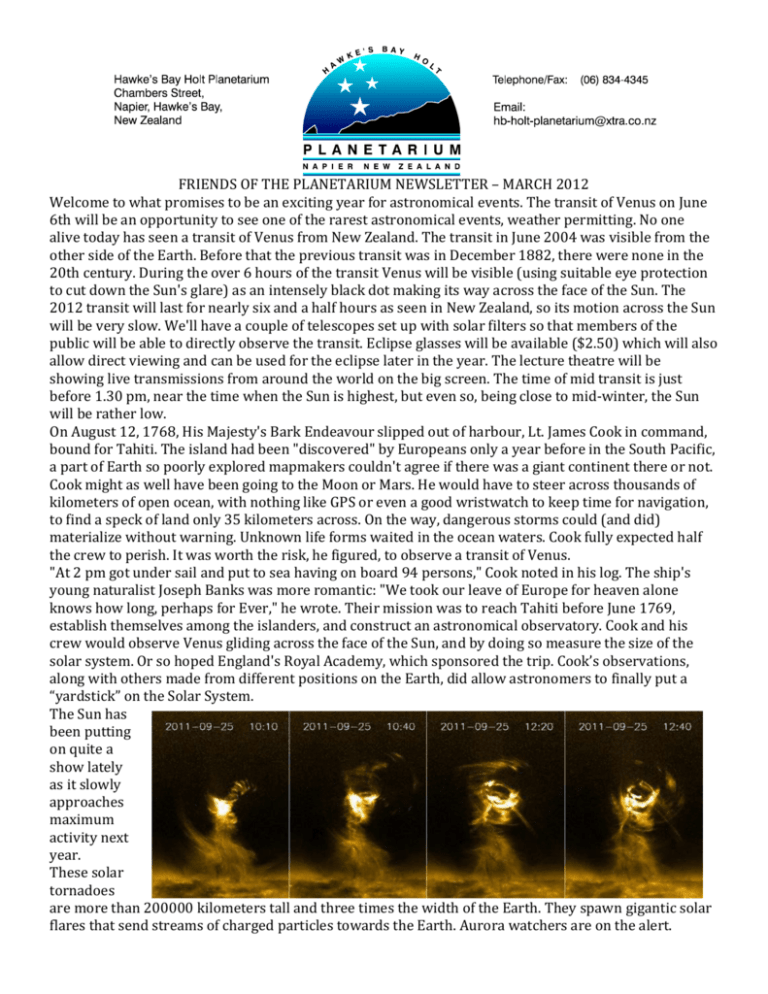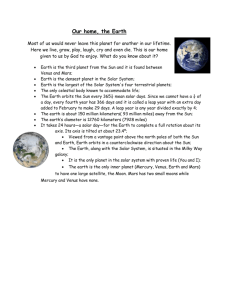friends of the planetarium newsletter
advertisement

FRIENDS OF THE PLANETARIUM NEWSLETTER – MARCH 2012 Welcome to what promises to be an exciting year for astronomical events. The transit of Venus on June 6th will be an opportunity to see one of the rarest astronomical events, weather permitting. No one alive today has seen a transit of Venus from New Zealand. The transit in June 2004 was visible from the other side of the Earth. Before that the previous transit was in December 1882, there were none in the 20th century. During the over 6 hours of the transit Venus will be visible (using suitable eye protection to cut down the Sun's glare) as an intensely black dot making its way across the face of the Sun. The 2012 transit will last for nearly six and a half hours as seen in New Zealand, so its motion across the Sun will be very slow. We'll have a couple of telescopes set up with solar filters so that members of the public will be able to directly observe the transit. Eclipse glasses will be available ($2.50) which will also allow direct viewing and can be used for the eclipse later in the year. The lecture theatre will be showing live transmissions from around the world on the big screen. The time of mid transit is just before 1.30 pm, near the time when the Sun is highest, but even so, being close to mid-winter, the Sun will be rather low. On August 12, 1768, His Majesty's Bark Endeavour slipped out of harbour, Lt. James Cook in command, bound for Tahiti. The island had been "discovered" by Europeans only a year before in the South Pacific, a part of Earth so poorly explored mapmakers couldn't agree if there was a giant continent there or not. Cook might as well have been going to the Moon or Mars. He would have to steer across thousands of kilometers of open ocean, with nothing like GPS or even a good wristwatch to keep time for navigation, to find a speck of land only 35 kilometers across. On the way, dangerous storms could (and did) materialize without warning. Unknown life forms waited in the ocean waters. Cook fully expected half the crew to perish. It was worth the risk, he figured, to observe a transit of Venus. "At 2 pm got under sail and put to sea having on board 94 persons," Cook noted in his log. The ship's young naturalist Joseph Banks was more romantic: "We took our leave of Europe for heaven alone knows how long, perhaps for Ever," he wrote. Their mission was to reach Tahiti before June 1769, establish themselves among the islanders, and construct an astronomical observatory. Cook and his crew would observe Venus gliding across the face of the Sun, and by doing so measure the size of the solar system. Or so hoped England's Royal Academy, which sponsored the trip. Cook’s observations, along with others made from different positions on the Earth, did allow astronomers to finally put a “yardstick” on the Solar System. The Sun has been putting on quite a show lately as it slowly approaches maximum activity next year. These solar tornadoes are more than 200000 kilometers tall and three times the width of the Earth. They spawn gigantic solar flares that send streams of charged particles towards the Earth. Aurora watchers are on the alert. The small, sun-scorched planet Mercury has an interior unlike that of any other rocky planet in our solar system and a surprisingly dynamic history, two new studies suggest. Using observations from NASA's Messenger spacecraft in orbit around Mercury, researchers have found that the planet's huge iron core is even larger than they had thought, and it's likely overlain with a solid shell of iron and sulfur, a layered structure not known to exist on Earth, Venus or Mars. And there's more: Mercury appears to have remained geologically active for a surprisingly large chunk of its evolutionary history, researchers said. The US$446 million Messenger (MErcury Surface, Space ENvironment, GEochemistry and Ranging) spacecraft was launched in 2004. It then took a circuitous route to the solar system's innermost planet, becoming the first probe ever to orbit Mercury in March 2011. Since then, Messenger has been zipping around the baking-hot planet, which orbits the sun from just 58 million kilometers away, compared to 150 million km for Earth, once every 12 hours. The probe is mapping Mercury's surface and gathering data on the planet's composition, magnetic environment and tenuous atmosphere, among other features. To date, Messenger has taken nearly 100,000 images and made more than 4 million measurements of the planet's surface, researchers said. The new findings should help shed light on Mercury's past, and on the formation and evolution of rocky planets in general. But they also serve to remind scientists that they're in for many more surprises as they continue to probe the solar system's many mysteries. Geologists are often surprised to find features on Earth replicated on other worlds: ancient riverbeds on Mars, lakes on Titan, and volcanic eruptions on Io. But researchers from the University of Washington have identified a geologic feature that exists on Mars, but not on Earth. These structures are known as periodic bedrock ridges. They look like sand dunes on the surface of Mars, but instead of sand piled high by strong winds, it appears that the wind has carved dune-like ridges right into the Martian bedrock. The ridges are probably a softer form of bedrock, which is easier for the Martian wind to erode it away. One similar feature on Earth is known as a “yardang”, but these are teardrop-shaped features parallel to the direction of the wind. But on Mars, these periodic bedrock ridges are perpendicular to the flow of the prevailing wind, just how sand dunes form on Earth (and Mars). The additional ingredient in the weather on Mars is probably some kind of deflection. The high speed surface winds are deflected up into the air by a land formation, and then they come down to the surface and create these periodic ridges. The length of the gap in the ridges depends on the strength of the wind, size of the deflection and the density of the atmosphere. A family in Oslo got a surprise when they visited their allotment garden cabin for the first time this season and found that a 585-gram meteorite had ripped a hole through the roof. The meteorite that landed on the cabin may very well have been blown off the surface of Mars at some point in the distant past, making it very rare. The find is potentially worth over US$500,000. Who needs Lotto!






